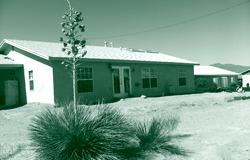June 2009
In this Issue
A Sustainability Framework Shapes the Future
Service Coordination Helps Low-Income Elderly Age in Place
Community Replicates Affordable Homes
Advancing Technology in Colonia Housing
In the next issue of ResearchWorks
Advancing Technology in Colonia Housing
Rural communities located within 150 miles of the U.S.-Mexican border often lack the necessities most Americans take for granted, such as running water and electricity. Mostly unincorporated, these Colonias first appeared in the 1950s, when developers sold small lots without any infrastructure to low-income individuals seeking affordable housing. Colonia neighborhoods today still lack safe, sanitary, and affordable housing and infrastructure, similar to the living conditions found in the developing world. Public services (such as paved roads, sewer and garbage services, water drainage, fire and police protection, streetlights, and transportation) are generally unavailable. Geographic isolation, lack of building codes, limited access to credit, and poverty all contribute to the substandard living conditions found in the Colonias.

Colonia residents also lack access to technology, the capital with which to purchase it, and information on how to use it to their best advantage. The Center for Environmental Resource Management's Energy Center at the University of Texas at El Paso is using its long history of community outreach to improve this situation. In 2004, with funds from a Hispanic-Serving Institutions Assisting Communities (HSIAC) grant administered by HUD's Office of University Partnerships, the Energy Center launched the Partnership for Advancing Technology in Colonia Housing (PATCH). PATCH seeks to accelerate the development and use of technologies that will radically improve the quality, durability, energy efficiency, environmental performance, and affordability of housing in Colonia neighborhoods.
Access to Energy-Efficient Housing Technology
Energy Center researchers believe that a home cannot be affordable unless it is energy efficient, and to achieve that goal is easier and less expensive than people tend to think. This research-based conclusion drives the Energy Center's outreach to Colonia residents with homes costing $60,000 or less, for whom cutting energy use is important. According to the Energy Center, the average U.S. family spends 3.5 percent of its budget on heating, cooling, lighting, and appliance energy, whereas low-income households spend about 14 percent. The PATCH program works to alleviate this burden for Colonia populations.
Under the auspices of PATCH, the Energy Center partners with nonprofit organizations in the Paso del Norte region of west Texas and southern New Mexico to help local residents acquire the best housing technology possible, build ENERGY STAR®-rated homes, and make small loans available for residents to purchase energy-efficient appliances. The program includes revolving loans, hardship grants, materials for new homes, and public information materials.
The Energy Center confronted the challenge of convincing builders to adopt energy-efficiency guidelines, which represented an additional cost of about $350 per home. The Energy Center estimated that $500 worth of energy-efficient features would add only $4 to a homeowner's monthly payment on a 30-year mortgage, but subtract as much as $20 to $30 a month from utility bills. For-profit builders were usually less interested in future savings for homeowners. For example, although a 3’ x 5’ low-E coated window cost only $11 more than a standard window, for-profit builders who were constructing 200 homes a year and installing 2,000 windows viewed the additional $22,000 in costs as significant.
Spreading the word about energy-efficient, affordable technology was easier among nonprofit builders. The Energy Center successfully used HSIAC funds to pay $500 to the El Paso Collaborative for Community and Economic Development (EPC) for every home that three nonprofit housing developers built to Energy Center specifications. This incentive offset the incremental costs of additional insulation, improved windows, and other upgrades, while allowing the nonprofit builders to try out new techniques and materials. By working closely with the builders, the Energy Center has played a leading role in building 22 ENERGY STAR-rated homes. A similar arrangement has also worked with another 15 nonprofit builders in the area, who between them have built 500 energy-efficient homes.
Access to Capital
To help Colonia residents gain access to the capital needed to take advantage of improved housing technology, the Energy Center also used HSIAC funds to underwrite a loan fund for housing technology, a revolving layaway loan fund for small purchases (such as home improvements and energy-efficient appliances), hardship grants for household purchases, and revolving loans for larger infrastructure improvements such as septic systems or water tanks. Grassroots organizations, including AYUDA Inc. of San Elizario, Texas and Colonias Development Council of Las Cruces, New Mexico promoted the loans to local residents, steering them away from rent-to-own stores, payday loans, and other predatory sources. The loans were administered by the EPC, providing Colonia families with a positive experience in doing business with a reliable lender. Each family successfully completing the loan program was given a letter to help with future credit applications.
Access to Information
The Energy Center also used HSIAC funds to inform local residents of the benefits of energy-efficient technologies and how to access them. Distributed through clinics, community groups, and faith-based organizations, fact sheets, flip charts, and a CD-ROM in both Spanish and English help familiarize residents with how to maximize energy efficiency. These resources explain how energy can be saved by using an evaporative cooling system with a low-voltage thermostat instead of refrigerated air conditioning, compact fluorescent bulbs (CFLs), altered laundry habits, and low-flow bathroom fixtures. For example, residents who wash clothes in cold water and install both low-flow showerheads and faucet aerators can reduce their hot water consumption by 50 percent, saving $117 each year. Residents also learn that replacing traditional light bulbs with CFLs will reduce lighting costs by 50 percent and save $47 annually.
The underlying purpose of the PATCH project has been to improve the living conditions of Colonia families through technology, capital, and knowledge, giving residents the tools they need to help themselves. An overview of the PATCH program is online at www.oup.org/conferences/presentations/hsiac/nasir_042106.pdf. To read more about HUD initiatives on behalf of Colonia communities, go to www.hud.gov/offices/cpd/communitydevelopment/programs/colonias/index.cfm.

